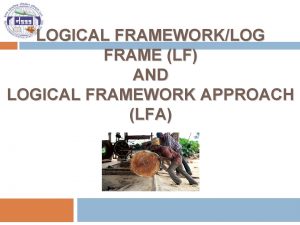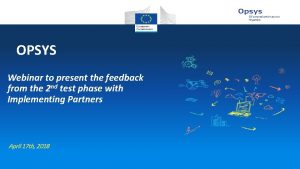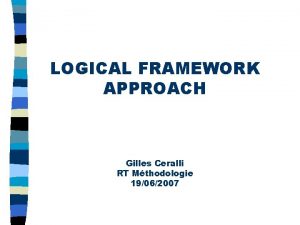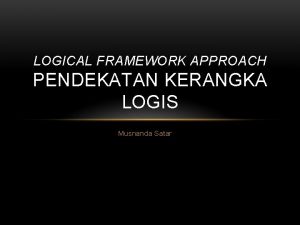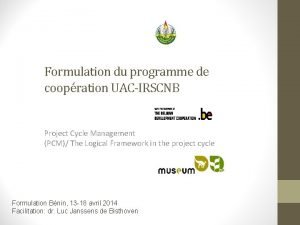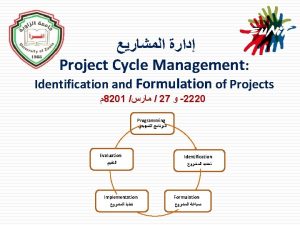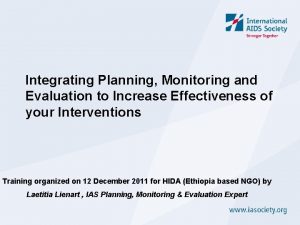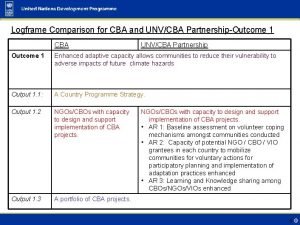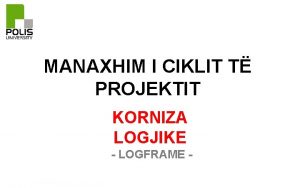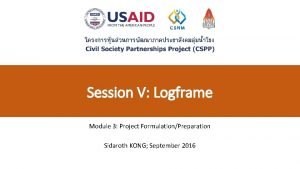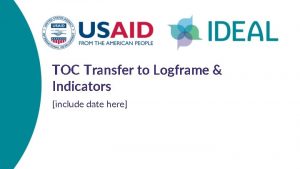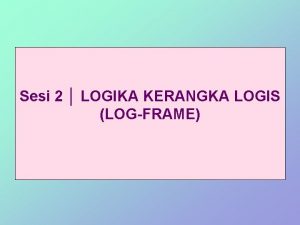Logframe of the Education Joint Programme Presentation to










- Slides: 10

Logframe of the Education Joint Programme Presentation to Provincial Workshop in Sindh May 20, 2008

Contents of this Presentation 1. Overall Structure § § Joint Programme Component 1 Joint Programme Component 2 Joint Programme Component 3 Joint Programme Component 4 2. Roles of the UN 3. Cross-Cutting Themes

1. Overall Structure Mega Outcome (1) MEGA JP Components (4) 1 2 3 4 JP Outcomes (18) Outputs (43) 14 9 10 10

JP Component 1 Output JP Outcome Universal, free and compulsory quality basic education for all children, especially girls Sustained policy commitment to education reform and increased budgetary allocations and expenditures for ECE (advanced kachi) and elementary education Improved elementary school enrolment, retention and completion especially for girls and vulnerable groups by 2010 Improved learning outcomes for all children who have reached grades 4 and 8 by 2010. Increased enrolment in pre-primary and ECE (advanced kachi) in selected districts by 2010 1. Community influentials, school, and district authorities to mobilized to encourage parents to enroll children in ECE 1. Policy, Reforms and Initiatives in Education for ECE and free and compulsory elementary education developed 1. Community influentials, school and district authorities mobilized to encourage parents to enroll their children, particularly girls 1. Primary and middle schools, especially for girls staffed with trained teachers, equipped with using, better learning materials in 25 dist. 2. Increased awareness among policy/decision makers including parliamentarians, CSOs and other stakeholderss on education reform, MDGs and EFA commitments 2. District education situation analysis in 25 dist 2. Increased knowledge of provincial, and district authorities and communities about learning achievement levels of students in their areas to facilitate edu planing 3. District education plans developed in 25 dist. 4. Community members mobilised, , , 5 and 6, , 2. Community members mobilized to participate in the management of school 3. Increased knowledge of district authorities about learning standards and best practices of EFE 4. Demonstrate best practice/strategies, , ,

JP Component 2 Literacy and non-formal basic education programmes for out-of-school children and youth, particularly girls and women Increased access to literacy and non -formal education by 2010 1. Increased awareness of policy makers and general public about the importance and functions of adult literacy and NFE emphasizing women’s participation 1. Increased # of Adult Literacy and NFE centres in selected districts especially for women and vulnerable groups Output JP Outcome Increased financial allocation for adult literacy and NFE programmes by 2010 2. Provincial/District literacy plans developed 2. Increased enrolment in adult literacy centers and higher completion rates of women 3. Increased # of gender focused literacy projects/organizations with strong post-literacy component Improved learning outcomes of literacy learners by 2010 1. Literacy centres staffed with trained male and female teachers and better learning materials Expanded coverage of NFBE for out-of-school children & youth, working children and industrial workers by 2010 Established system of equivalence and certification for adult literacy and NFBE by 2010 1. Increase in # of Non. Formal Basic Education Schools (NFBES) for girls, boys and refugees (where applicable) in selected districts 1. Equivalency policy and guidelines for females and males developed 2. Equivalency policy and guidelines piloted in the selected districts

JP Component 3 Output JP Outcome Strengthened Education System through institutional capacity development Ensured mechanisms for partnerships among all stakeholders and non-state actors for education reform by 2010 1. Established Coordination and Networking bodies comprising all stakeholders (including public and non-state actors) in selected districts Improved education governance of districts by 2010 Expanded coverage and analysis of learning outcomes for all levels and types of basic education, including adult literacy and NFBE, by 2010 1. Enhanced capacity of dist. Govt to design and implement improved edu governance practice and tools 1. Learning assessment capacities strengthened at national and provincial levels to support districts 2. Increased knowledge and skills of district education officials about their responsibilities and roles 2. A mechanism in place for independent and regular assessment of learning achievements of learners of adult literacy centers. 3. Merit-based procedure &mechanisms Improved system for data collection, analysis, and use for planning and budgeting, policy making at all levels by 2010 1. Implementation of integrated decision support system (Integrated EMIS at national and sub national levels) 2. Strengthened EMIS and capacities at district level for planning and policy formulation Increased provision of quality teacher education and training (in-service and pre-service), especially for female teachers by 2010 1. Enhanced capacities of teacher training institutes 2. Standards for teachers education developed

JP Component 4 Output JP Outcome Secondary education with a focus on technical and vocational education (TVE) and life skills development for adolescents and youth Free and compulsory secondary education Increased enrolment by 2010 Improved learning outcomes for all secondary students by 2010 1. Revision in National and Provincial policies, plans and budgets for secondary, including technical stream, education 1. Secondary schools for boys and girls staffed with trained teachers, eqipped with, and using better learning material 2. Community influentials, schools and district authorities mobilized to encourage parents to enroll their in secondary education, especially girls, in selected districts 2. Increased knowledge of province and district authorities and communities about learning achievement levels of male and female students in their areas to facilitate education planning Increased enrolment in demand-driven TVET with a focus on girls and vulnerable groups by 2010 1. Up-to-date policy for technical education in general and technical schools drawing on recent successful trends and practices 2. Strategies and plan for technical education in general school and technical schools in place 3. Increased infrastructural facilities for TVE and life skills especially for girls, , , 4. Community influentials, , , Strengthened institutional capacities of TVET sector by 2010 1. Technical Capacity, curriculum and coordination strengthened for effective implementation of the national skill strategy 200812 2. Increase in the # of teaching and learning facilities in TVETs in selected districts

Roles of the UN • Advisor • Advocate • Convener of Stakeholders • Provider

Cross-Cutting Themes • Human Rights • Gender • Civil Society Organizations • Refugees

Mega Outcome By 2010, increased access to, and improved quality of, primary and secondary education, literacy and nonformal education, technical & vocational education for all children and youth, especially girls and women, to be achieved through sustained political commitment, efficient use of resources and strengthened institutional capacities

